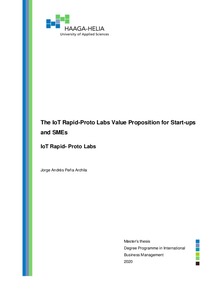The IoT Rapid-Proto Labs Value Proposition for Start-ups and SMEs
Peña Archila, Jorge Andres (2020)
Lataukset:
Peña Archila, Jorge Andres
2020
All rights reserved. This publication is copyrighted. You may download, display and print it for Your own personal use. Commercial use is prohibited.
Julkaisun pysyvä osoite on
https://urn.fi/URN:NBN:fi:amk-2020061018146
https://urn.fi/URN:NBN:fi:amk-2020061018146
Tiivistelmä
The objective of the study is to identify and suggest relevant elements of value on which the IoT Rapid-Proto Labs will focus to correctly structure, define and create a value proposition for the start-ups and SME’s segments. Hence, the study develops on the idea of value creation in the context of university-industry cooperation and explores further on the concept of value proposition. Hence, a theoretical tool called “The Value Proposition Canvas” is used for mapping the elements of value which are essential for the start-ups and SMEs market segments.
The study uses an inductive research method, and primary qualitative data were collected through semi-structured interviews with start-ups and SMEs. The aim of these semi-structured interviews was to understand their interpretation of the value enhancing elements. Additionally, the secondary data were gathered through Internet searches, as saved time and resources.
During the data collection and analysis of the research findings only the start-ups and SMEs perspectives were considered. The viewpoints of the HEIs and staff involved in the IoT Rapid-Proto Labs were excluded as they are not considered relevant for the identification of the needs and sources of anxieties of the start-ups and SMEs customer segments. Hence, the study exemplifies an outsider’s viewpoint which provides an impartial analysis and assessment of these results.
The research interviews with start-ups and SMEs revealed that many types of jobs, pains and gains include concerns around activities such as funding, scalability, lack of operational capital, access to technical knowledge and other day-to day activities on which firms engage in order to generate revenue and eventually profit. Subsequently, interviewees highlighted that HEIs have different working pace compared to the private commercial consultancy firms. Hence, rapid-prototyping and rapid MVP deployment for commercialisation is a requirement sought from potential HEIs partners.
In conclusion, this study recommends to create of a new value proposition based on interviewees suggestions, which includes two different components: cost effective rapid-prototyping and co-creation of MVP, rapid deployment for commercialisation. Moreover, the current four IoT Rapid Proto Labs value propositions were included as product and services within the value proposition canvas aiming to build an improved value proposition.
The study uses an inductive research method, and primary qualitative data were collected through semi-structured interviews with start-ups and SMEs. The aim of these semi-structured interviews was to understand their interpretation of the value enhancing elements. Additionally, the secondary data were gathered through Internet searches, as saved time and resources.
During the data collection and analysis of the research findings only the start-ups and SMEs perspectives were considered. The viewpoints of the HEIs and staff involved in the IoT Rapid-Proto Labs were excluded as they are not considered relevant for the identification of the needs and sources of anxieties of the start-ups and SMEs customer segments. Hence, the study exemplifies an outsider’s viewpoint which provides an impartial analysis and assessment of these results.
The research interviews with start-ups and SMEs revealed that many types of jobs, pains and gains include concerns around activities such as funding, scalability, lack of operational capital, access to technical knowledge and other day-to day activities on which firms engage in order to generate revenue and eventually profit. Subsequently, interviewees highlighted that HEIs have different working pace compared to the private commercial consultancy firms. Hence, rapid-prototyping and rapid MVP deployment for commercialisation is a requirement sought from potential HEIs partners.
In conclusion, this study recommends to create of a new value proposition based on interviewees suggestions, which includes two different components: cost effective rapid-prototyping and co-creation of MVP, rapid deployment for commercialisation. Moreover, the current four IoT Rapid Proto Labs value propositions were included as product and services within the value proposition canvas aiming to build an improved value proposition.
